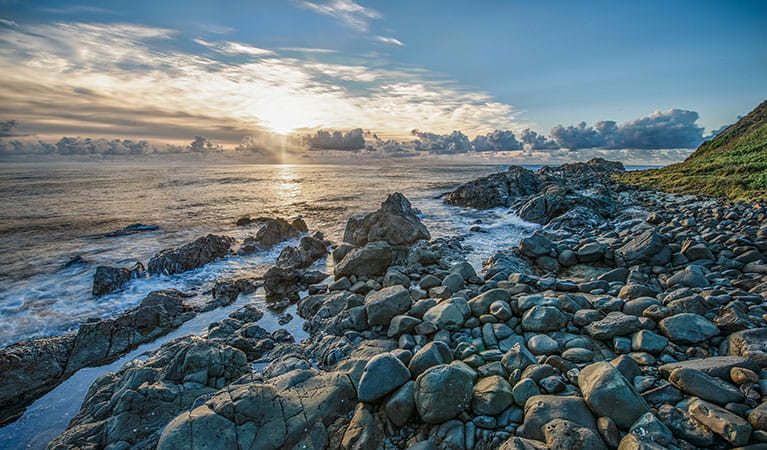Saltwater National Park
Overview
At this small coastal reserve east of Taree, you can bushwalk, canoe, kayak, swim, fish, surf, picnic, and even whale watch from August through November.
Read more about Saltwater National Park
Saltwater National Park is a small coastal reserve surrounded by rainforest, just east of Taree. It's a popular seasonal camping spot for local Aboriginal people, and its convenient coastal locale means that surfers, swimmers and fishers find it equally attractive.
Saltwater Beach is a much-loved surfing area, also great for swimming and sunbathing. The large, well-equipped Saltwater picnic area, adjacent to the beach, makes a perfect spot to relax between swims. Wallabi Beach is great for a surf. Or, you can paddle a canoe, kayak, or fish amongst the mangroves along Khappinghat Creek.
The views from Headland walking track are not only spectacular, it's a great place to go whale watching. From August through to November, you might spot humpback whales on their annual migration.
All year round, be sure to keep an eye out for bottlenose dolphins surfing the waves, sea eagles swooping into the sea to catch their prey, and brush turkeys wandering along the tracks in search of food.
Local alerts
For the latest updates on fires, closures and other alerts in this area, see https://www.nationalparks.nsw.gov.au/visit-a-park/parks/saltwater-national-park/local-alerts
Contact
- in the North Coast region
Saltwater National Park is always open but may have to close at times due to fire danger.
-
-
Taree office
02 6552 4097
Contact hours: Monday to Friday, 9am to 4.30pm. - 78 Hargreaves Drive, Taree NSW 2430
-
Email: npws.manninggreatlakes@environment.nsw.gov.au
-
Taree office
Visitor info
All the practical information you need to know about Saltwater National Park.
Map
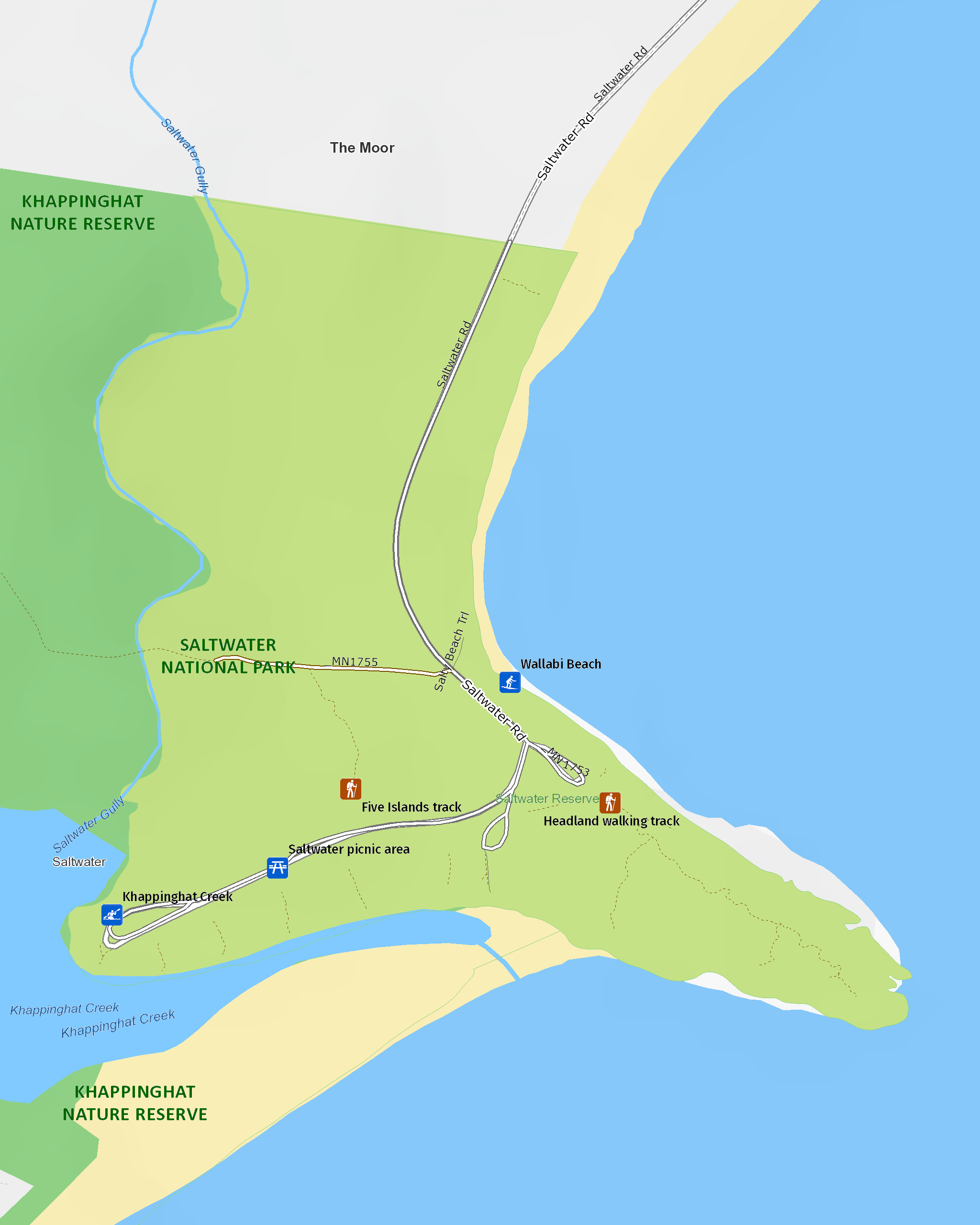
Map legend

Getting there and parking
Get driving directions
From Taree or the Pacific Highway:
- Take Old Bar Road then turn right at Saltwater Road. Follow Saltwater Road to Saltwater National Park.
Parking
- Khappinghat Creek See on map
- Saltwater picnic area See on map
- Wallabi Beach See on map
By bike
Check out the Bicycle information for NSW website for more information.
By public transport
There is no public transport available to Saltwater National Park.
Best times to visit
There are lots of great things waiting for you in Saltwater National Park. Here are some of the highlights.
Autumn
Take walks around the headland and through to adjoining Khappinghat Nature Reserve.
Spring
Enjoy whale watching from the viewing platform at Saltwater Point from August through November.
Summer
Swim, surf and sunbathe on the beaches, canoe and kayak in the creek, or enjoy a picnic on the grass under the shady rainforest trees.
Weather, temperature and rainfall
Summer temperature
Average
17°C and 29°C
Highest recorded
45.2°C
Winter temperature
Average
8°C and 21°C
Lowest recorded
-5°C
Rainfall
Wettest month
March
Driest month
August
The area’s highest recorded rainfall in one day
280.2mm
Facilities
Amenities
Toilets
Picnic tables
Boat ramp
Drinking water
Showers
Maps and downloads
Prohibited
Pets
Pets and domestic animals (other than certified assistance animals) are not permitted. Find out which regional parks allow dog walking and see the pets in parks policy for more information.
Smoking
NSW national parks are no smoking areas.
Nearby towns
Old Bar (7 km)
As well as its beachside attractions, Old Bar is an ideal base for exploring nearby natural attractions. Crowdy Head National Park and the beautiful waterways of Myall lakes National Park are just two of the best.
Taree (18 km)
Taree is a major mid North Coast city, ringed by superb beaches. It's situated on the Manning River and set against rolling hills.
Forster (44 km)
Dominated by water sports Forster is the centre of the Great Lakes area.
Learn more
Saltwater National Park is a special place. Here are just some of the reasons why:
Surf's up
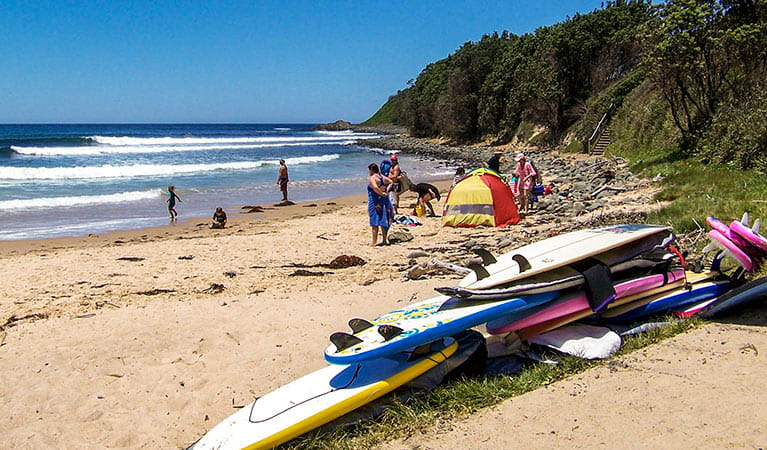
Saltwater Beach's headland is a highly popular surfing point break used for recreational surfing, as well as club and competition surf events. Take a stroll through a rainforest walking track, and be sure to do a spot of whale watching at Saltwater Point. The adjacent Saltwater Beach and Wallabi Beach are popular surfing and swimming areas.
- Khappinghat Creek At the flat water Khappinghat Creek, kayak or canoe through undeveloped wetlands, mangroves and rainforest. Swimming and fishing near Taree on the mid-north coast of NSW.
- Saltwater picnic area Enjoy relaxed picnicking or barbecues at this well-equipped picnic area with ocean beaches and walking tracks nearby where you can swim, fish, surf, kayak or birdwatch.
Unique geology and landscape
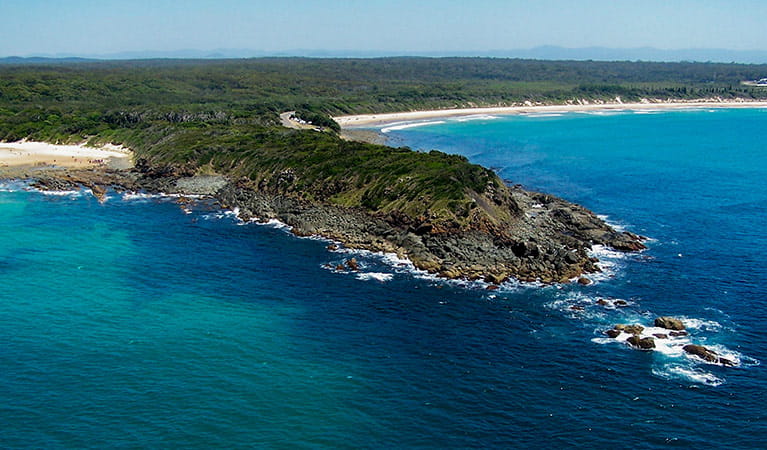
Saltwater headland, which separates Wallabi Beach and Saltwater Beach, is one of only three headlands between Wallis Lake and the Manning River. Khappinghat Creek, which borders the park, is the largest area of undeveloped wetlands and the only naturally opening and closing estuarine system on the mid-north coast of NSW.
- Five Islands walking track This gorgeous coastal walking track follows a part of the Saltwater National Park coastline that is rich in Aboriginal history with great spots for swimming, fishing, surfing, and sailing, near Taree.
- Headland walking track This short walk around the headland takes you to a whale watching viewing platform, has Aboriginal history, is near Khappinghat Nature Reserve near Taree.
Striking plant life
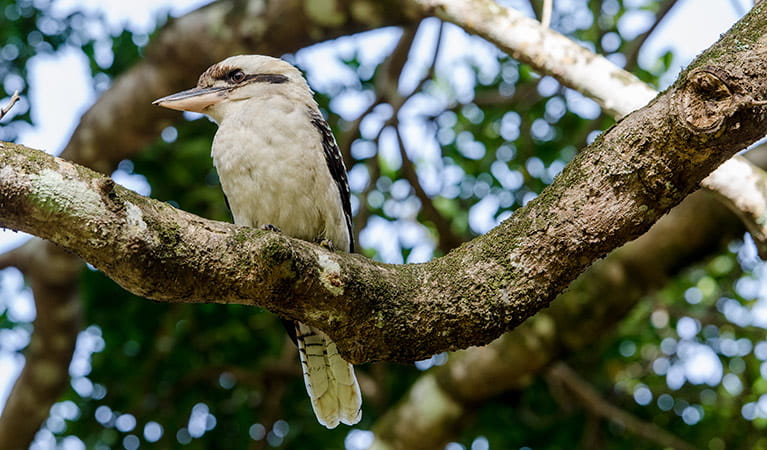
Parts of the park are listed as endangered ecological communities and there are a number of rare and lovely plant species to be spotted here. Keep your eyes out on the walking tracks for magenta lilly pilly, a small tree with dark shiny leaves, magenta-coloured fruit and white-flowered wax plant. Pink-flowering pinnate boronia, and the golden flowers of the wallum banksia, among others, can all be seen in Saltwater National Park. The park also supports many marine-dependant species, such as the white-bellied sea eagle, as well as endangered or vulnerable species including the pied oystercatcher, little tern, the flesh-footed shearwater and osprey.
- Headland walking track This short walk around the headland takes you to a whale watching viewing platform, has Aboriginal history, is near Khappinghat Nature Reserve near Taree.
Spiritually significant landscape
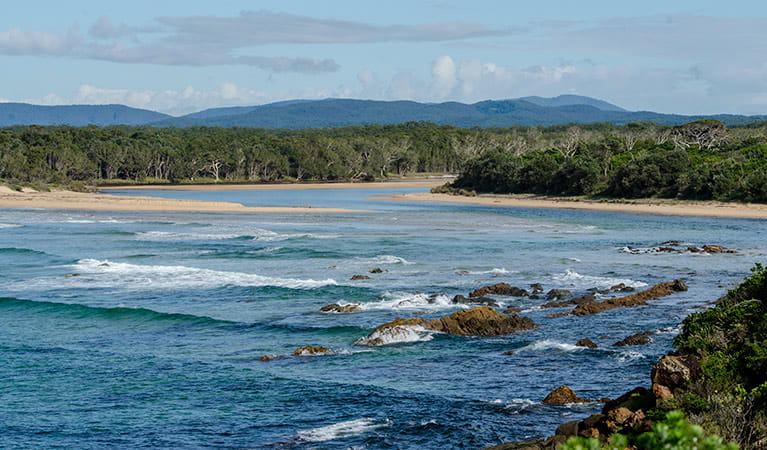
Saltwater Beach and its surrounds are a cultural landscape of great importance to the local Aboriginal Biripi tribe. There are several sites related to the Dreamtime within the park, and the area is declared an Aboriginal Place. Joint management with Aboriginal people and local residents, in association with Saltwater Tribal Council and NPWS, gives this park special local importance.
- Five Islands walking track This gorgeous coastal walking track follows a part of the Saltwater National Park coastline that is rich in Aboriginal history with great spots for swimming, fishing, surfing, and sailing, near Taree.
- Saltwater picnic area Enjoy relaxed picnicking or barbecues at this well-equipped picnic area with ocean beaches and walking tracks nearby where you can swim, fish, surf, kayak or birdwatch.
Education resources (1)
What we're doing
Saltwater National Park has management strategies in place to protect and conserve the values of this park. Visit the OEH website for detailed park and fire management documents.

